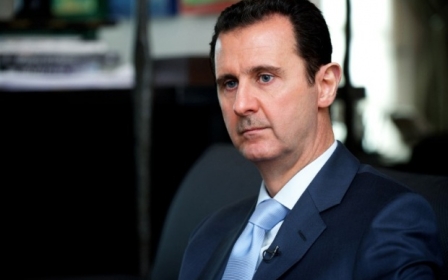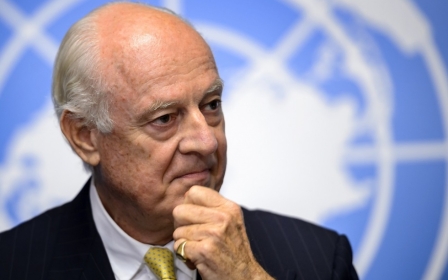Iran building long-term influence in Syria

Recent weeks have seen the Syrian economy deteriorate further and the national currency, the Syrian pound, fall to an all-time low.
Four years of an uprising-turned-civil war have taken their toll on Syria’s economy and society. Following European sanctions on its oil sector and the takeover of all the main oil fields by ISIL and Kurdish groups, the government has stopped generating foreign currency receipts, while the destruction of most business activity has reduced fiscal revenues. Increasingly, the government is seeking the help of its allies, Iran and Russia, to fill the gap.
Iran, in particular, has taken a leading role in providing financial support to Damascus.
In January 2013, it extended a credit line of $1 billion. The Syrian government could use the money to pay for imports with the condition that 60 percent of these imports came from Iran. Since then many tenders issued by public sector companies have included the mention that bidding is open only to Iranian companies.
Then, in August 2013, Tehran provided another credit line, this time worth $3.6 billion, dedicated to the purchase of oil products, also mostly from Iran.
These two financial agreements helped Iran increase its share of Syrian imports to a third of the total.
Historical economic ties very weak
Prior to the uprising, and contrary to the depth of their security and political relations, economic and trade ties between the two countries were actually very weak. In 2010, for instance, bilateral trade reached only $320 million, compared with $2.5 billion for trade between Syria and Turkey and even $940 million for trade with the United States - in spite of long-standing sanctions imposed by Washington on Damascus for the latter’s alleged support of terrorism. Iranian investments in Syria also paled compared with those from the Gulf and the European Union.
The relative modesty of these ties was a consequence of several factors: trade networks between the two countries are historically limited compared, for instance, with those existing between Damascus and the Hijaz, and between Aleppo and Mosul or the Turkish hinterland; they have no common borders and are separated by Iraq with which both countries had conflictual relations and closed borders for decades. Finally the two economies are not complementary and none produces or trades products that are competitive in the other’s market.
In addition, after his arrival to power in 2000, Bashar Al-Assad built economic ties with Turkey and Arab countries in an apparent bid to balance the strategic ties existing with Iran. While Syria joined the Greater Arab Free Trade Area in 2005 and signed a free trade agreement with Turkey in 2007, it did not bother to do the same with Iran. The two countries signed a preferential trade agreement only in 2011, after the beginning of the uprising and the deterioration of relations with Turkey and the Arab world.
Finally, there was always an element of suspicion in these relations and one example is particularly telling.
In the summer of 2010, Syria issued a tender for the award of a third mobile phone licence in the country. The government received six offers from France Telecom, Saudi Telecom, Turkcell (Turkey), Q-Tel (Qatar), Etisalat (UAE) and Toseye Eatemad Mobin, an Iranian company believed to be tied to the revolutionary guards.
A few months later, and only weeks before the beginning of the uprising, the Ministry of Telecommunications announced its shortlist. It decided to prequalify five of the companies and to reject one… the Iranian company.
Iran capitalising on Syria’s weakness
Today, short of money, and of allies, the Syrian regime is left with little choice but to accept the conditions of the Iranians.
In the short-term, it is unlikely Iran will stop providing funds to Damascus, at least the bare minimum required to help keep the regime afloat - Tehran has simply invested too much in the Syrian war to give up now.
On 6 May, Adib Mayaleh, the governor of the Central Bank of Syria, told Bloomberg that Tehran was close to granting an additional $1 billion. The amount may have actually already been disbursed given that the Central Bank pumped dozens of millions of dollars in the first week of May to help prop up its currency.
However, for larger amounts of money, Iran is likely to capitalise on the weakness of its ally. Reports have emerged that the Iranians are seeking to obtain collaterals from the Syrian government in the form of real estate assets or other state properties.
What is clear is that the Syrian regime has become strongly dependent on Iran’s economic aid, which adds to its reliance on Tehran’s political and military support. This carries significant political risk because it makes the regime much less capable of resisting potential pressures from its ally.
If Iran were also to obtain collaterals for the aid it is granting, and therefore get hold of important Syrian assets, it would guarantee for itself significant political influence in Syria that would last long after the end of the regime.
- Jihad Yazigi is a journalist based in Beirut. He is the editor-in-chief of The Syria Report, an online economic bulletin specialised on the Syrian economy that he founded in 2001.
The views expressed in this article belong to the author and do not necessarily reflect the editorial policy of Middle East Eye.
Photo: Syrian President Bashar al-Assad (R) meeting with Iranian Minister of Economy and Finance Ali Tayebnia in Damascus on 16 March. (AFP / HO/ SANA)
Middle East Eye propose une couverture et une analyse indépendantes et incomparables du Moyen-Orient, de l’Afrique du Nord et d’autres régions du monde. Pour en savoir plus sur la reprise de ce contenu et les frais qui s’appliquent, veuillez remplir ce formulaire [en anglais]. Pour en savoir plus sur MEE, cliquez ici [en anglais].





